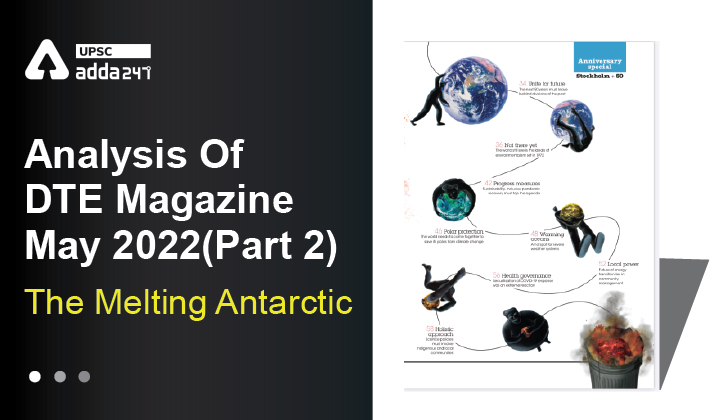Table of Contents
Introduction
Since 1995, major ice shelves have been melting in Antarctica and scientific consensus is that the next major geographic event will be the breaking of Antarctica.
About Antarctica
- Antarctica, defined as all land and ice shelf south of 60°S, but not the sur- rounding waters, is regulated by the Antarctica Treaty System (ats) ratified on December 1, 1959, which predates the 1972 Stockholm Declaration.
What is Antarctica Treaty System(ATS)?
- December 1 is observed as Antarctica Day as on December 1 1959 the ATS was ratified.
- The treaty aims for peaceful exploration of the continent for science and prohibits military activity other than as support for research; free exchange of information and personnel with the UN and other international agencies; prohibits new territorial claims; disallows nuclear explosions or disposal of radioactive wastes; and gives treaty state observers free access to all stations, premises and equipment.
- Before this treaty was ratified, the UK, Norway, New Zealand, Chile, Argentina, Australia, and France had made territorial claims in Antarctica.
- Australia’s claim is the largest; almost half of the entire continent.
- By not signing the treaty, the US, Russia, South Africa, Peru, and Brazil reserve the right to make territorial claims.
- As of 2022, ats has been signed by 53 countries.
Did India sign ATS and what does it mean?
- India signed it in 1983, attracting opposition within the country and from third-world nations that were initially against ats for its rule of “no new territorial claims”.
- This rule means earlier claims by the rich na- tions must be respected by the signatoties.
- In a way, ats is similar to the Nuclear Non-Proliferation Treaty: both endorse privileges to “original” players in the field—wealthy imperialists— and can be termed vestiges of colonialism.
- Alvaro de Soto, a Peruvian diplomat, once stated ATS would enable the rich and powerful to turn Antarctica into “their private hunting grounds.”
Impact of Global Warming on Antarctica
- The effects of global warming are becoming apparent in Antarctica, with rapid melting of glaciers, changes in plant distribution, and breaking of ice sheets.
- Occurrences of warm winds have intensified, increasingly forming massive sastrugi (wavelike ridges of snow, formed perpendicular to the wind direction).
- East Antarctica is colder and more resilient to the effects of global warming than the western part.
- Scientists have confirmed that the central-west region of the continent is the most-rapidly warming region; it has warmed 2.5°C since 1950, almost five times than the rest of the world.
- Some 87 per cent of glaciers in the Antrarctic Peninsula are in retreat. The sliding of ice streams—glaciers that are 50 km wide and up to 1 km thick that slide on the muddy base and drain the ice into the ocean— is accelerating.
What this could lead to?
- A substantial rise in global sea level.
- The melting of Antarctica’s ice is so massive that the resulting mass imbalance has caused changes in the Earth’s gravitational forces.
- “Greenifihcation” of the continent is another significant concern; as Antarctica gets warmer, species distributed in temperate and sub-polar regions can be introduced here.
India’s scientific expedition to Antarctica
- India began its Antarctica expedition in 1981.
- It has two stations: Maitri (in an area claimed by Norway) and Bharati (under Australia’s claimed territory).
- Earlier this year, the Centre drafted the Antarctic Bill for governance of the stations.



 TSPSC Group 1 Question Paper 2024, Downl...
TSPSC Group 1 Question Paper 2024, Downl...
 TSPSC Group 1 Answer key 2024 Out, Downl...
TSPSC Group 1 Answer key 2024 Out, Downl...
 UPSC Prelims 2024 Question Paper, Downlo...
UPSC Prelims 2024 Question Paper, Downlo...





